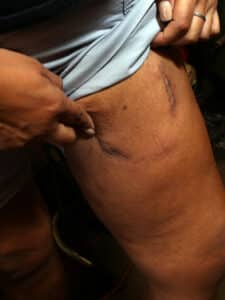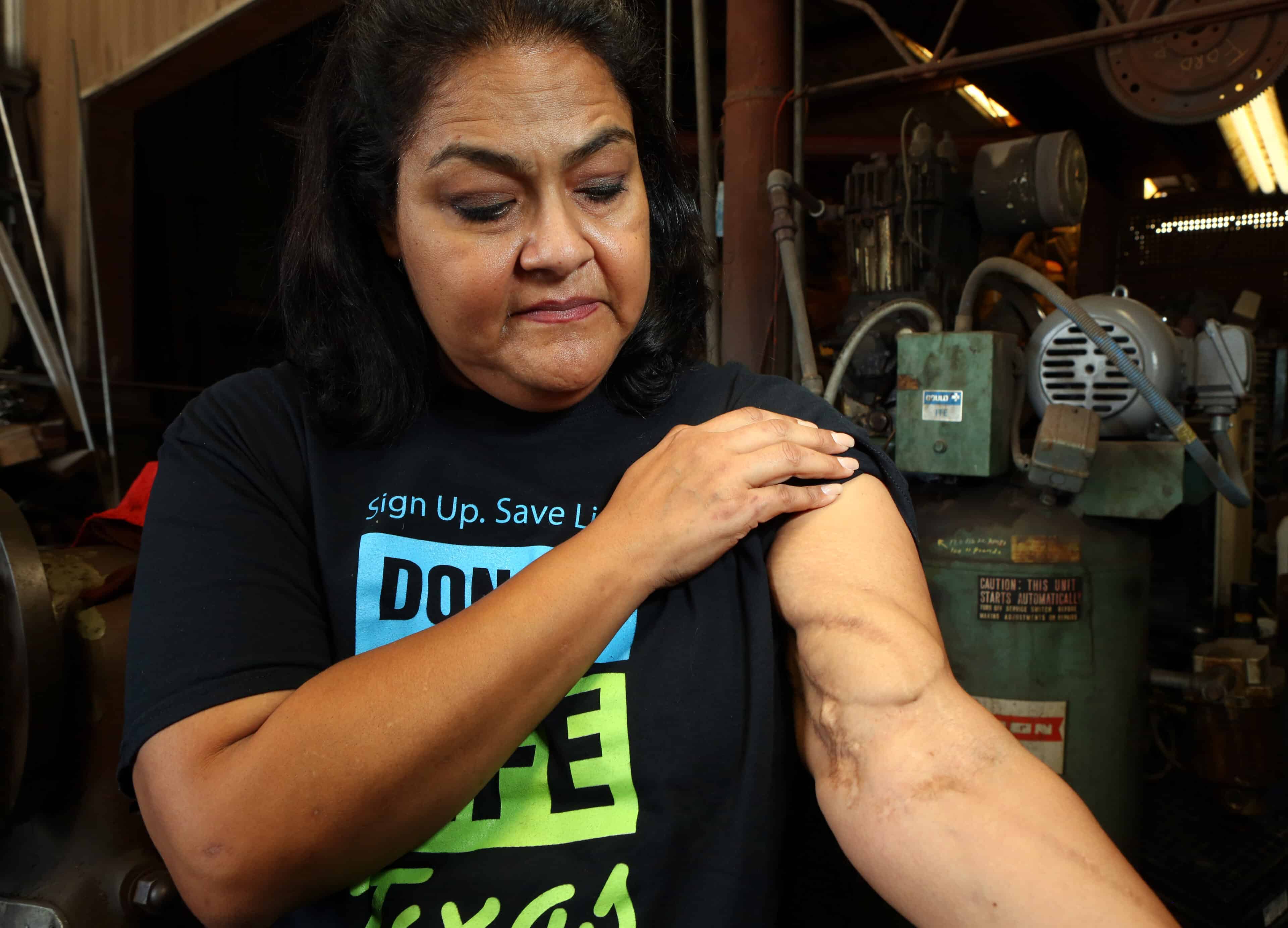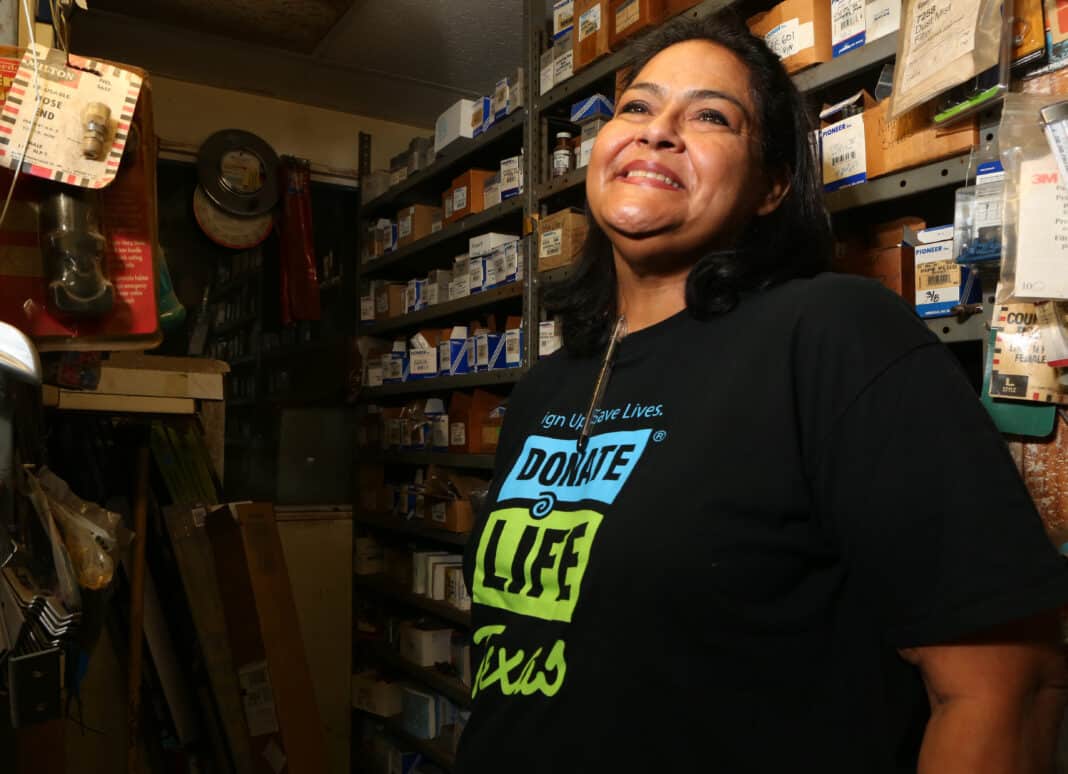
Etched onto Anjanette Gonzales’ left thigh are two long scars, dark ridges that seem to draw out parentheses on her lap.
Tough words lie in between those parentheses: pain from countless punctures and procedures, frustration from never feeling comfortable, and sadness from the loss of her independence.
Scars run all over Gonzales’ body serving as proof of her long fight to live after her kidneys stopped working a decade ago, tethering her to machines that cleaned her blood and drew water from her body for years, and tying her future to a national list of hundreds of thousands of others also waiting for organ transplants.
A new kidney was the key to returning to the life she had planned for herself. The Pharr native who graduated from the then-University of Texas-Pan American in 1999 was living in Dallas at the time she was diagnosed with kidney failure. Gonzales was a juvenile probation officer there, a job she loved dearly but had to quit once her condition got worse.
When Gonzales lifts her left arm, eight years of waiting for a kidney — eight years of being hooked and unhooked to blood-filtering dialysis machines — are clearly shown.
Dialysis is a treatment that does the work of kidneys, ridding blood of waste and toxins. This means that when Gonzales started dialysis, she never had to urinate. On some occasions she would get phantom urges to use the restroom.
A person on dialysis will have two tubes inserted into their bloodstream, one pulling blood out and another letting it back in. Eventually, every drop of a person’s blood will run through the machine for cleaning. “But not as good as kidneys,” Gonzales said.
Clusters of scars run along the 49-year-old’s upper arm, and a long one cuts diagonally through her forearm — the latter marking the first time she had dialysis done in 2011, a procedure doctors did immediately when they found out her kidneys were failing, not caring much for how big of a scar tubes would leave.
Gonzales went to five-hour dialysis appointments three times a week for the eight years.
“You just sit there and wait,” she said. Somedays, she passed time by napping, chatting with other patients, or working on her graduate homework.
Other days she’d just sit there and cry.
At one point, Gonzales’ arm was poked so much that a nerve there was nicked and her arm froze. Her hand was stuck curled for about four months. That’s when doctors moved to her thighs for dialysis.
When she was first diagnosed, Gonzales thought she would be able to return to her life in Dallas in two years, at most. She heard stories of people receiving a kidney transplant in months.
But then the third year came and went, then the fourth, then fifth, and eventually the eighth.
Gonzales had to wait longer for her kidney because she is Hispanic, and people of color are less likely to receive organs from live donors, according to research published by the American Medical Association.
Organ transplants require a duo who are similar genetically and since there are fewer people of color registered as organ donors, they are less likely to find matches.
In a two-year period of waiting for a kidney, researchers found that 11.4% of white patients received one — double the rate of Hispanic patients, of which 5.9% found matches.
The average life expectancy of a person on dialysis is about 10 years, and in 2018 when Gonzales reached her seventh year of waiting, she asked her organ transplant coordinator to take her off the list. “I started mentally preparing myself to not see 50,” she said.
Her coordinator pushed her to be more patient, and on Feb. 7, Gonzales received the phone call she thought would never come: she matched with an organ donor and a kidney was being flown from California for her.
She and her family drove up to Houston that evening for her transplant surgery the next day. Gonzales now proudly shares with others that she has three kidneys inside of her. Only one of them is working, but that’s enough for her to be extremely grateful.
Gonzales will be turning 50 later this year and gets excited whenever she has to urinate — it’s a sign that her new kidney is working.
April is National Donate Life Month, which was established by Donate Life America, a nonprofit with the mission of facilitating transplants of organs, eyes and tissues across the nation.
Gonzales obtained her master’s degree in social work at the University of Texas Rio Grande Valley in 2017 because her own transplant journey compelled her to advocate for others still waiting.

This wasn’t Gonzales’ first kidney transplant, though.
On July 13, 2018, Friday the 13th that year, she matched to an organ donor and had a transplant surgery the following day.
All the tests showed that the transplant should have gone fine. The kidney was healthy. Blood tests showed that Gonzales was ready to accept the new organ.
“But it never really worked from the time they connected that kidney to me,” she said. “Sometimes transplants just don’t work.”
Even though the person who received the other kidney was doing well, Gonzales’ just wasn’t.
The following year, she had surgery to get it removed.
“That was definitely the lowest point I have ever been in,” she said. “Usually my mom stays with me in the hospital, but this time I told her, ‘Just go home, I need to be by myself for the next couple of days.’”
She recalled crying the whole drive home from Houston, lamenting returning to dialysis clinics and relying on machines, once again, to live.
Being on dialysis meant Gonzales had to learn how to live with a parched mouth all the time because every drop of water she drank would stay with her until her next appointment.
There were days when she didn’t track her water consumption well enough and her face swelled so much that the face ID feature to unlock her phone wouldn’t recognize her.
Her family and friends were her source of strength through trying times. Gonzales became good friends with another woman who also would get dialysis done in McAllen. They would coordinate their appointments so they could be there together, and in the clinic, nurses and doctors knew them as the playful, trouble-making duo.
“The doctor would tell us, ‘I don’t know who put you two crazy girls together,’” Gonzales recalled, chuckling.
Her dialysis partner kept her grounded, reminding her to stay positive and strong. When she died six months later, Gonzales was not only heartbroken, but was left asking when her turn would be.
Not her turn to receive a kidney, but to be one of the 20 people in the country who die each day waiting for an organ transplant, according to the American Transplant Foundation.
“I would pray that today wasn’t my day,” she said.
With her new kidney, Gonzales seizes every day. She works hard at her family’s machine shop, Pan American Automotive in Pharr, and hopes to become a social worker for a transplant organization in the future. She also never takes for granted that she gets to urinate.
If she had found a kidney transplant much earlier, she may have been able to move back to Dallas and continue her career in criminal justice. And she thinks of this often.
Now, her goal is to push more people, especially those in the Rio Grande Valley, to sign up to be organ donors.
“It’s about getting people to understand that you can be somebody else’s hero,” Gonzales said. “You can make an impact on somebody else’s life, and it’s not just that one life. It’s like a river that ripples when you throw a rock in it because not only did my donor change my life, she changed the life of my friends, the life of my parents, and hopefully the people I will soon help as a social worker.
“So, like our saying goes, if you aren’t going to use it, why not lose it.”
To learn how and where you can register to become an organ donor, check out the story below:





